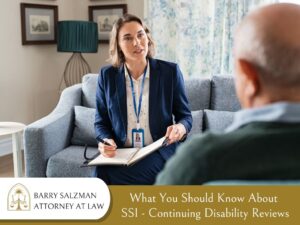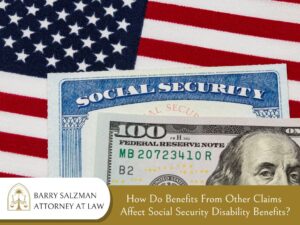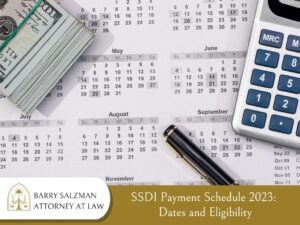PTSD Disability Claims Under Social Security Act and Veterans’ Law
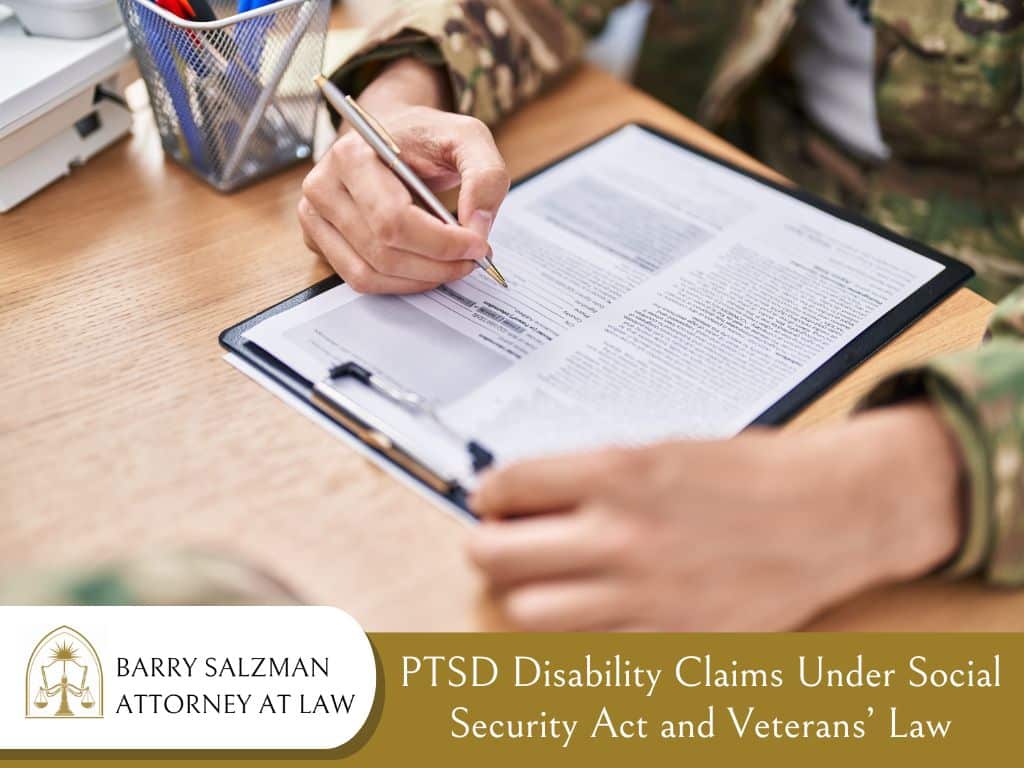
What is PTSD?
PTSD is the abbreviation for “post-traumatic stress disorder”. PTSD is a mental disorder defined for medical purposes in the Diagnostic and Statistical Manual (DSM), which is the accepted medical source for diagnosing mental disorders (published by the American Psychiatric Association). The current manual is the 5th edition, otherwise known as DSM-5. The current criteria for defining PTSD:
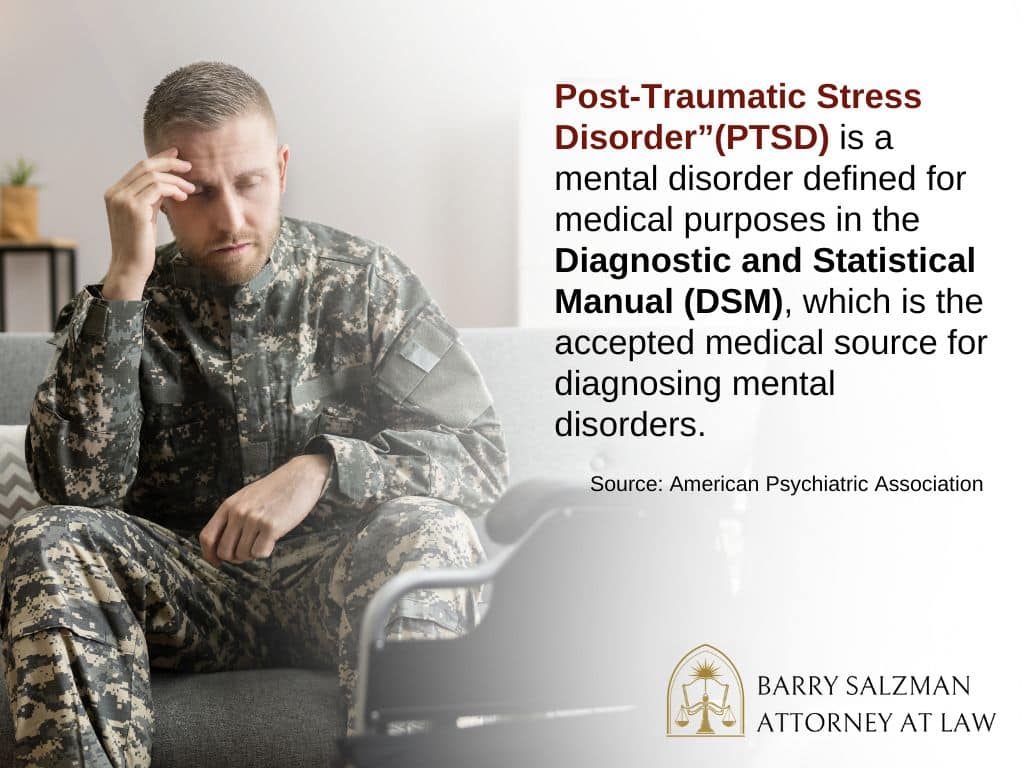
DSM-5 Criteria for PTSD
Note: The following criteria apply to adults, adolescents, and children older than six years. For children six years and younger, see the DSM-5 section titled “Posttraumatic Stress Disorder for Children 6 Years and Younger”.
- Exposure to actual or threatened death, serious injury, or sexual violence in one (or more) of the following ways:
- Directly experiencing the traumatic event(s).
- Witnessing, in person, the event(s) as it occurred to others.
- Learning that the traumatic event(s) occurred to a close family member or close friend. In cases of actual or threatened death of a family member or friend, the event(s) must have been violent or accidental.
- Experiencing repeated or extreme exposure to aversive details of the traumatic event(s) (e.g., first responders collecting human remains; police officers repeatedly exposed to details of child abuse). Note: Criterion A4 does not apply to exposure through electronic media, television, movies, or pictures, unless this exposure is work-related.
- Presence of one (or more) of the following intrusion symptoms associated with the traumatic event(s), beginning after the traumatic event(s) occurred:
- Recurrent, involuntary, and intrusive distressing memories of the traumatic event(s). Note: In children older than 6 years, repetitive play may occur in which themes or aspects of the traumatic event(s) are expressed.
- Recurrent distressing dreams in which the content and/or affect of the dream are related to the traumatic event(s). Note: In children, there may be frightening dreams without recognizable content.
- Dissociative reactions (e.g., flashbacks) in which the individual feels or acts as if the traumatic event(s) were recurring. (Such reactions may occur on a continuum, with the most extreme expression being a complete loss of awareness of present surroundings.) Note: In children, trauma-specific reenactment may occur in play.
- Intense or prolonged psychological distress at exposure to internal or external cues that symbolize or resemble an aspect of the traumatic event(s).
- Marked physiological reactions to internal or external cues that symbolize or resemble an aspect of the traumatic event(s).
- Persistent avoidance of stimuli associated with the traumatic event(s), beginning after the traumatic event(s) occurred, as evidenced by one or both of the following:
- Avoidance of or efforts to avoid distressing memories, thoughts, or feelings about or closely associated with the traumatic event(s).
- Avoidance of or efforts to avoid external reminders (people, places, conversations, activities, objects, situations) that arouse distressing memories, thoughts, or feelings about or closely associated with the traumatic event(s).
- Negative alterations in cognitions and mood associated with the traumatic event(s), beginning or worsening after the traumatic event(s) occurred, as evidenced by two (or more) of the following:
- Inability to remember an important aspect of the traumatic event(s) (typically due to dissociative amnesia, and not to other factors such as head injury, alcohol, or drugs).
- Persistent and exaggerated negative beliefs or expectations about oneself, others, or the world (e.g., “I am bad,” “No one can be trusted,” “The world is completely dangerous,” “My whole nervous system is permanently ruined”).
- Persistent, distorted cognitions about the cause or consequences of the traumatic event(s) that lead the individual to blame himself/herself or others.
- Persistent negative emotional state (e.g., fear, horror, anger, guilt, or shame).
- Markedly diminished interest or participation in significant activities.
- Feelings of detachment or estrangement from others.
- Persistent inability to experience positive emotions (e.g., inability to experience happiness, satisfaction, or loving feelings).
- Marked alterations in arousal and reactivity associated with the traumatic event(s), beginning or worsening after the traumatic event(s) occurred, as evidenced by two (or more) of the following:
- Irritable behavior and angry outbursts (with little or no provocation), typically expressed as verbal or physical aggression toward people or objects.
- Reckless or self-destructive behavior.
- Hypervigilance.
- Exaggerated startle response.
- Problems with concentration.
- Sleep disturbance (e.g., difficulty falling or staying asleep or restless sleep).
- Duration of the disturbance (Criteria B, C, D, and E) is more than one (1) month.
- The disturbance causes clinically significant distress or impairment in social, occupational, or other important areas of functioning.
- The disturbance is not attributable to the physiological effects of a substance (e.g., medication, alcohol) or another medical condition.
Two Specifications
With Dissociative Symptoms
The individual’s symptoms meet the criteria for posttraumatic stress disorder, and in addition, in response to the stressor, the individual experiences persistent or recurrent symptoms of either of the following:
- Depersonalization: Persistent or recurrent experiences of feeling detached from, and as if one were an outside observer of, one’s mental processes or body (e.g., feeling as though one were in a dream; feeling a sense of unreality of self or body or of time moving slowly).
- Derealization: Persistent or recurrent experiences of unreality of surroundings (e.g., the world around the individual is experienced as unreal, dreamlike, distant, or distorted).
Note: To use this subtype, the dissociative symptoms must not be attributable to the physiological effects of a substance (e.g., blackouts, behavior during alcohol intoxication) or another medical condition (e.g., complex partial seizures).
With Delayed Expression
If the full diagnostic criteria are not met until at least six (6) months after the event (although the onset and expression of some symptoms may be immediate).
PTSD Under Social Security Law
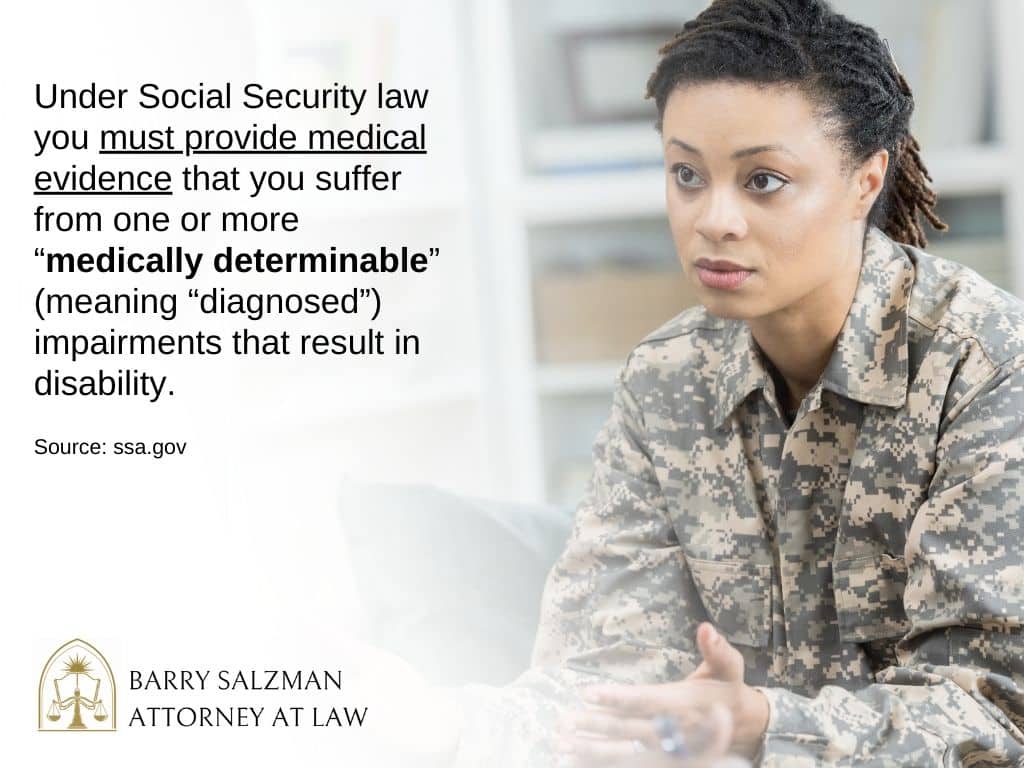
Under Social Security law, you must provide medical evidence that you suffer from one or more “medically determinable” (meaning “diagnosed”) impairments that result in disability. Testimony from the claimant or other lay persons concerning the presence of several criteria cannot take the place of a qualified physician’s diagnosis of PTSD. In some instances, Social Security may not accept or give much weight to the opinions of physicians or other health care providers who are not mental health providers (psychiatrists and psychologists). Social security regulations require that medical diagnoses must be established by “acceptable medical sources”:
(a) Acceptable medical source means a medical source who is a:
(1) Licensed physician (medical or osteopathic doctor);
(2) Licensed psychologist, which includes:
(i) A licensed or certified psychologist at the independent practice level; or
(ii) A licensed or certified school psychologist or other licensed or certified individual with another title who performs the same function as a school psychologist in a school setting for impairments of intellectual disability, learning disabilities, and borderline intellectual functioning only;
(3) Licensed optometrist for impairments of visual disorders or measurement of visual acuity and visual fields only, depending on the scope of practice in the State in which the optometrist practices;
(4) Licensed podiatrist for impairments of the foot or foot and ankle only, depending on whether the State in which the podiatrist practices permits the practice of podiatry on the foot only or the foot and ankle;
(5) Qualified speech-language pathologist for speech or language impairments only. For this source, qualified means that the speech-language pathologist must be licensed by the State professional licensing agency, or be fully certified by the State education agency in the State in which he or she practices, or hold a Certificate of Clinical Competence in Speech-Language Pathology from the American Speech-Language-Hearing Association;
(6) Licensed audiologist for impairments of hearing loss, auditory processing disorders, and balance disorders within the licensed scope of practice only (with respect to claims filed (see § 404.614) on or after March 27, 2017);
(7) Licensed Advanced Practice Registered Nurse, or other licensed advanced practice nurse with another title, for impairments within his or her licensed scope of practice (only with respect to claims filed (see § 404.614) on or after March 27, 2017); or
(8) Licensed Physician Assistant for impairments within his or her licensed scope of practice (only with respect to claims filed (see § 404.614) on or after March 27, 2017).
The Role of Functional Limitations in PTSD Disability Claims
Establishing a qualified diagnosis of PTSD is not sufficient to establish disability. As in all cases, Social Security must determine whether the diagnosed impairment(s) result in functional limitations that limit your ability to work. The symptoms of PTSD may cause frequent panic attacks, loss of the ability to concentrate, cognitive problems, inability to deal with the normal stress of the work environment, and inability to deal appropriately with the public, co-workers, and supervisors. Such symptoms may result in an inability to complete a normal work shift, an inability to attend work on a regular and continuing basis, and an inability to maintain an acceptable level of concentration, persistence, and pace in work activity.
Documenting Symptoms and Their Impact for PTSD Disability Claims
When seeking disability benefits due to PTSD, it is imperative to be able to document the symptoms you exhibit and the effects those symptoms have on daily activities. Typically, persons trying to work with PTSD will have attendance and disciplinary issues that the employer can document. Managers, co-workers, and family can corroborate those difficulties with testimony or written statements. Mental health care in today’s world typically includes a psychiatrist who prescribes medication and a psychologist or licensed mental health care counselor who provides counseling and psychotherapy. Psychiatrists manage medication, but the counselors who see you on a regular basis frequently have the most information and insight into how PTSD is affecting you. Records and statements from those counselors may be critical in a judge’s consideration of your claim.
PTSD Under Veterans’ Law
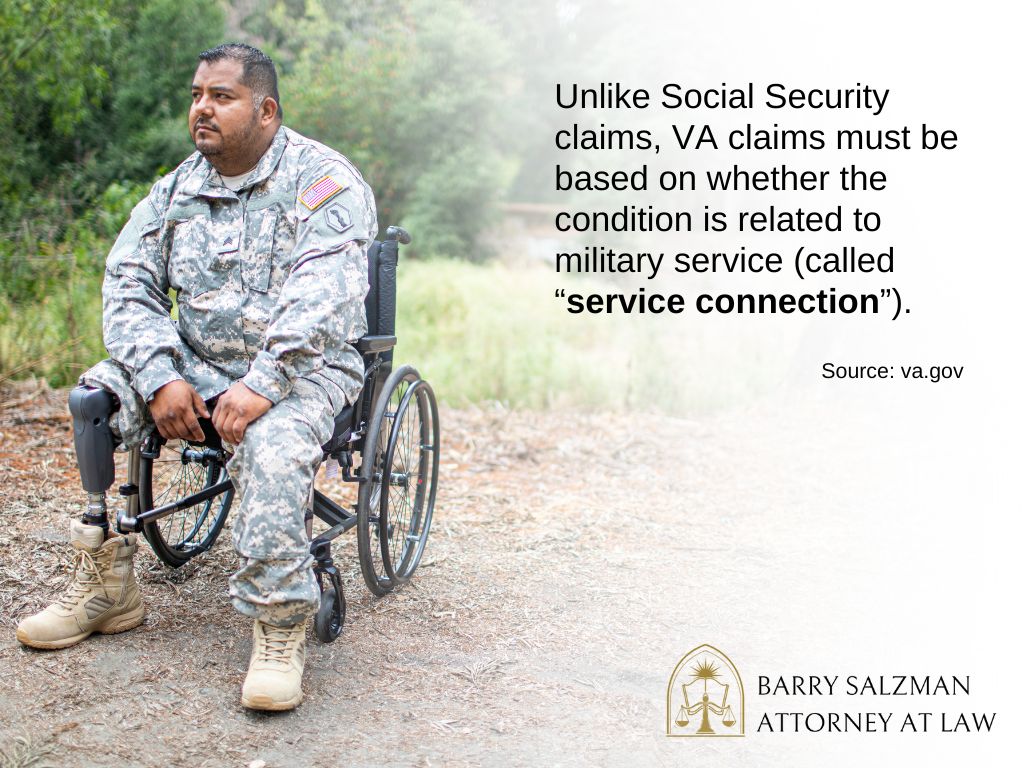
As with Social Security law, the VA requires a medical diagnosis for PTSD. Although you may be receiving mental health care from a VA physician or private physician, the VA typically requires a VA examination to establish a diagnosis for PTSD. These are called Compensation & Pension (C&P) examinations. You would think that the VA would accept a diagnosis by a treating VA psychiatrist, but no, the VA doesn’t work that way. More troubling is that the C&P examiner may not be a psychiatrist or even a psychologist. The VA often uses physician’s assistants to conduct the examinations. The C&P exam uses a disability benefits questionnaire in which the examiner conducts an interview with the veteran and checks off boxes relating to symptoms, severity, and effects on work activity. The C&P examiner is then asked to express an opinion on whether the examination supports a diagnosis of PTSD. The VA examiner must use the DSM-5 to make the diagnosis.
The Role of DSM-5 Criteria in PTSD Diagnosis
Unlike Social Security claims, VA claims must be based on whether the condition is related to military service (called “service connection”). The examiner must find whether there is a service connection. In some cases, VA regulations make service connection easier by providing presumptions of service connection if, for example, PTSD is based on participation in wartime combat. Due to experience with veterans from the Gulf Wars and Afghanistan, the VA has recognized that some veterans have developed PTSD from “fear of hostile military or terrorist activity” without evidence of participation in combat. Prisoners of war are likewise presumed to be service connected. In these instances, there must be clear and convincing evidence to support a denial of service connection.
Even in cases where a VA physician is treating the veteran for PTSD, the VA examiner may decline to find a diagnosis for PTSD because one or more elements of the DSM-5 criteria are missing. These cases may nonetheless result in a diagnosis of a similar disorder based on depression or anxiety.
The VA’s Approach to Rating PTSD
In such instances, the VA will usually diagnose an “other acquired psychiatric disorder”. In these cases, the precise diagnosis does not matter. The VA rates all mental disorders under a uniform rating schedule for mental disorders. The ratings are based on the degree to which the condition affects one’s ability to work. In other words, whether you are diagnosed with PTSD or other acquired psychiatric disorders, if the condition substantially limits your ability to perform work activity and interpersonal relationships, you will get a 50%-70% rating.
The Importance of Secondary Service Connection in PTSD Cases
There is another aspect in VA cases where a diagnosis of PTSD can be very important. VA law provides that a service connection may be established when one service-connected disability causes another condition not related to the service. We call this a “secondary service connection”. Secondary service connection applies to circumstances where a rated disability causes another non-service condition or where the rated disability aggravates a non-service condition. In the context of PTSD cases, this can become important because several other conditions have been found to be related to PTSD, including migraine headaches and sleep apnea. For example, a veteran with a 50% rating for PTSD may be able to show that his sleep apnea is related to his PTSD. The VA usually provides a 50% rating for sleep apnea. This veteran now has a 100% rating.
Substance Abuse and PTSD
Many veterans (particularly those with combat experience) with PTSD have alcohol and drug problems. The VA is considerate of this issue. There are few medications that effectively provide relief from PTSD symptoms. Psychotherapy, whether individually or in groups, is not always effective because many veterans feel that talking about their problems makes them worse, not better. Sadly, alcohol and drugs are often how many try to alleviate the mental pain they experience. The VA will provide secondary service connections for drug or alcohol abuse and provide additional ratings in these cases. This is not true in Social Security cases! Under Social Security law, disability may be denied if drug or alcohol abuse is considered a “material contributing factor” rendering the claimant disabled. This means that there is sufficient evidence to establish that the claimant would not be disabled but for substance abuse.
This issue is not usually relevant in cases involving physical conditions such as spinal conditions that are disabling due to severe pain. Discontinuance of drugs or alcohol will not relieve the pain or grow new arms and legs in cases of amputation. On the other hand, conditions such as depression, anxiety, and bipolar disorder are generally worsened by substance abuse, and few judges believe otherwise. That said, PTSD isn’t going away when one stops abusing drugs or alcohol. In Social Security cases, one must be prepared to deal with this issue.
In Conclusion

Please keep in mind that PTSD is based on a person having had some horrific experience that has produced an intense reaction. What causes one person to be able to witness such events without such effect while another can’t get over it, can’t be explained. Judges are human. They respond as most of us do to what we consider “reasonable” based on life experiences. A person claiming PTSD, because he witnessed a raccoon being run over by a car, may not present as persuasive a case as the combat war veteran.
PTSD often may represent a delayed reaction to remote events. This is typically seen in children who have experienced physical, emotional, or sexual abuse but don’t manifest symptoms until later in life. It is not uncommon for adults who have experienced sexual assault to block it out for a while until something triggers the repressed feelings. A personal friend and Vietnam veteran returned from the war, a seemingly well-balanced person who ran a successful business for years until an inconsequential event brought his fears and memories to the surface. He took his life a short time thereafter. PTSD is serious; it can and does lead to suicide.
Don’t guess about your case! Get advice and counsel from an experienced and knowledgeable attorney. Call Attorney Barry Salzman Today at (727) 321-4993.
Schedule Your Consultation Today
Navigating the bureaucracy of any disability program is complex and frustrating and often ends in denial.
Don't do it alone! Have a dedicated, experienced advocate on your team.
Fill out the form below or give us a call at 727-321-4993.

